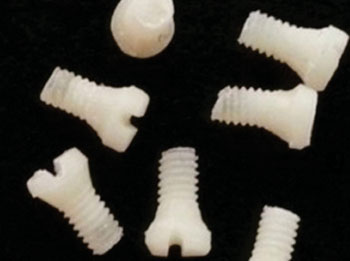Silk-Based Surgical Implants Repair Broken Bones
By HospiMedica International staff writers
Posted on 27 Mar 2014
A new study shows that fixation devices derived from silkworm silk are potentially attractive alternatives to metal and synthetic-based systems.Posted on 27 Mar 2014
Researchers at Tufts University (Medford, MA, USA) and Beth Israel Deaconess Medical Center (BIDMC; Boston, MA, USA) have developed surgical plates and screws made from pure silk protein derived from silkworm cocoons that may not only offer improved bone remodeling following injury, but importantly, can also be absorbed by the body over time, eliminating the need for surgical removal of the devices.

Image: Surgical screws derived from silkworm silk protein (Photo courtesy of Tufts University).
The researchers used silk protein obtained from Bombyx mori silkworm cocoons to form the surgical plates and screws. Produced from the glands of the silkworm, the silk protein is folded in complex ways that give it unique properties of both exceptional strength and versatility. To test the new devices, the investigators implanted a total of 28 silk-based screws in six laboratory rats. Insertion of screws into the rat femurs was straightforward, and assessments were then conducted at four weeks and eight weeks, postimplantation.
The results showed that the self-tapping screws remained fixed to the bone, exhibited biocompatibility, and promoted bone remodeling. According to the researchers, the silk-based devices compare favorably with current poly-lactic-co-glycolic acid fixation systems; however, the silk-based devices offered conformal fit to the repair site, sterilization by autoclaving, minimal inflammatory response, and mechanical integrity even when coming into contact with fluids and surrounding tissue during surgery. The study was published on March 4, 2014, in Nature Communications.
“Unlike metal, the composition of silk protein may be similar to bone composition,” said co-senior author Samuel Lin, MD, of the division of plastic and reconstructive surgery at BIDMC and associate professor of surgery at Harvard Medical School (Boston, MA, USA). “Silk materials are extremely robust. They maintain structural stability under very high temperatures and withstand other extreme conditions, and they can be readily sterilized.”
“Because the silk screws are inherently radiolucent it may be easier for the surgeon to see how the fracture is progressing during the post-op period, without the impediment of metal devices,” added Dr. Lin. “And having an effective system in which screws and plates ‘melt away’ once the fracture is healed may be of enormous benefit. We’re extremely excited to continue this work in larger animal models and ultimately in human clinical trials.”
“One of the other big advantages of silk is that it can stabilize and deliver bioactive components, so that plates and screws made of silk could actually deliver antibiotics to prevent infection, pharmaceuticals to enhance bone regrowth, and other therapeutics to support healing,” added senior coauthor David Kaplan, PhD, of Tufts University, a leader in the use of silk for biomedical applications.
Related Links:
Tufts University
Beth Israel Deaconess Medical Center














